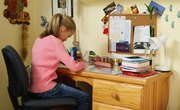Of the many projects students are assigned by their teachers, one of the most extensive is a portfolio. A portfolio can be created for a variety of different reasons. Sometimes, they're to demonstrate your experience in one area, and other times, they're to highlight your work for an entire semester or year of school. A portfolio is not only a great way to showcase everything from your projects and assignments to homework and tests, but it's also something physical you can have to look back on when you're older. Students in different grades will have different requirements for their portfolio assignment, but in general, portfolios tend to follow more or less the same guidelines.
How to Make a Portfolio for a School Project
If you're required to make a portfolio for a school project, then it's likely that your teacher will give you some guidelines. They may tell you what needs to be included in your portfolio, as well as the deadline for your portfolio.
A portfolio project is never something that should be left for the last minute. Both students and teachers have a responsibility to outline what's required so that students can be sure to save their projects and assignments throughout the year. If they end up in the garbage, then students will have a hard time completing their portfolio. Teachers can facilitate this by telling their students to go out and buy a binder or folder at the beginning of the year and require students to always put their work inside as they get it back from their teacher. They can organize the work later.
If you're wondering how to make a portfolio for a school project, your best bet is to get a binder with plastic sleeves inside. This way, you can add as much as you want, re-order papers and make sure your papers won't get ruined because they'll be protected by the sleeves. The rest will come later.
Why Portfolios Are Important
The reason that portfolios are such an important part of the student's course requirements is because they're used as an assessment tool for both teachers, students and their peers. By looking at the portfolio, teachers are able to get an overall look at how the student performed and grew over the semester or year. They can determine whether or not the student has met the specific standards set by the curriculum.
As for the student, they're able to do some self-reflection to understand more about their capabilities and achievements over the time they were in the class. They should evaluate their own work and discover assignments and projects they feel that they've done well on, as well as assignments or projects they felt that they could have improved on. Teachers can also give their students a space to do some peer review where they can give and receive some positive input about their work.
Lastly, as students get older, they might be wondering how to make a high school portfolio for college. A high school portfolio can help students obtain a scholarship for college or help them stand out in a college admissions' interview. Therefore, students should always keep their portfolio in the best possible condition, so that it can be used again and again if necessary.
Student Portfolio Ideas
If your teacher is giving you some creative flexibility with your portfolio, then there are many student portfolio ideas out there that you can use for inspiration. While a first grader, a fifth grader and a high schooler may all have different ideas and abilities when it comes to making a portfolio, there's no reason you can't have fun with it as long as your teacher says it's okay.
In addition to purchasing a binder, some students may find that they'd prefer to build their portfolio in a photo album or scrapbook, or they want to make the entire thing from scratch. Visit your local art store, and you'll see all the different things you can add to your portfolio. From stickers and ribbons to decorative paper and styled scissors, there's no limit as to what you can do with your portfolio. Just remember that it still must include everything you're told to include. It's also a good idea to keep your creativity simple because adding too much can be distracting and take away from the content within.
Online Portfolio vs. Physical Portfolio
Visiting the art store will certainly help you create a physical portfolio, but it may not help you with creating an online portfolio. Today, many teachers require students to build their portfolio completely online. Some require the portfolio to be accessible online as well as in a physical space. Teachers who require online portfolios may introduce you to the software they're using, or they may ask you to make a PowerPoint portfolio or a series of Docs saved in a shared file.
Whether or not you need an online portfolio, you should always keep a backup of your work on a flash drive or in the cloud. Since most students type up their work on the computer anyway, you should always save it somewhere in an organized manner, so you can go back and retrieve it later just in case. You never know if your computer might break with all your files stored there, or if you spill coffee on your physical portfolio and need to replace some of the pieces inside.
What to Include in Your Portfolio
Though most teachers should give guidelines about what to include in your portfolio, students in high school may merely be given suggestions of what to add, whereas younger students may be given much more support. Both high school students and elementary school students will generally have the same objective when it comes to their portfolio and the pieces they decide to include. Students can also take a look at student portfolio samples of high school students or elementary students to get a better idea:
- Journal entries
- Artwork
- Awards and certificates
- Projects and assignments
- Conference reports and report cards
- Photos
- Tests and quizzes
- Writing samples
- Reading logs
- Science experiments/lab reports
- Essays
All portfolios should have a variety of all these items. For instance, instead of including 10 essay examples, you should consider adding one of each or two of each item. Once you've decided what to include, your portfolio should also have a table of contents and in many cases, an essay. Some teachers may require you to divide your portfolio into sections and write a short essay or reflection to summarize each of these sections.
Should You Photocopy Work?
When it comes time to put your pieces into your portfolio, you may be wondering whether or not you should photocopy your assignments and examples from projects, or if you should use the originals. This is really up to your teacher to decide, and if they don't have an opinion on it, then you can make the choice for yourself. If you're planning to use the portfolio for more than just your grade, then you should consider using some originals. If you do use photocopies, make sure that the quality of the copies are just as good as the originals, and keep the originals somewhere safe in case you ever need them.
Writing Your Portfolio Essay
If you're required to write a portfolio essay (even if you aren't, it doesn't hurt to include one), it shouldn't be too difficult to write. After all, your portfolio essay is simply an overview of what the readers can expect to find in your portfolio, and what they should understand about you as a student. It should give some brief descriptions of your best work and achievements throughout the year, as well as things you found challenging and things you believe you could have improved on. In most cases, your portfolio essay doesn't need to be very long. Most students can get away with writing one to two pages. When you're finished, your essay can be situated at the beginning of your portfolio.
How to Make a Portfolio for College
The portfolios you may be asked to put together as a student in elementary school, middle school or high school will be quite different from any portfolio you're required to make in college. Depending on your degree of study, you may be required to present a portfolio upon your completion of a course or your entire four years at the school. Similar to creating a portfolio while you're in your younger years, your professors or academic advisor should provide you with some insight as to what you should include in your portfolio. And, especially if this will be a comprehensive portfolio featuring what you've learned over your time in school, then you should be sure to keep all your assignments and projects in a very safe place until it's time to present them.
Portfolios in college may include different content depending on your major. For instance, if you studied education, you may be required to create a portfolio not just of your work, but the work of the students you've taught over the years, demonstrating that you've had an impact on their learning based on the instructions you were given. If you studied photography, then you may be required to present your photos as well as certain examples of how your work has improved over time. And it's important to remember that one of the reasons your major is requiring this from you is because it will be useful when it's time to apply for a job in your field.
Your Portfolio Presentation
After putting in all that hard work into completing your portfolio, there is some work left to do. Some teachers may require their students to present their portfolios either in a one-on-one conference, in front of the rest of the class or at a formal portfolio presentation. A portfolio presentation is a good opportunity to express your oral communication skills, and in some cases, the presentation may also be included as part of your portfolio grade. Therefore, take some time to choose what points you would like to discuss about your portfolio and practice giving your presentation a couple of times before you're due to present.
Storing Your Portfolio
Once you complete your portfolio assignment, you have the option to keep it or throw it away if you don't think you'll need it again in the future. But most students, including younger students, choose to store their portfolio in a place where they can look back on it months or years later. A portfolio is a great way to understand yourself at a younger age, and they're simply fun to look through. Perhaps if you grow up to have children of your own one day, and they ask you how to make a portfolio for a school project, you can use your past portfolios to show them an example. You should think about storing your portfolios in a box or on a bookshelf, where you can always find them quickly.
Related Articles
References
Tips
- Ideally, your portfolio should be 20 to 25 pages.
- Keep the content neat and easy to read. Avoid large fonts, bright colors or other distracting features.
- Have a friend or teacher review your portfolio for any spelling errors that you might easily overlook.
Writer Bio
Hana LaRock is a freelance content writer from New York, currently living in Mexico. Before becoming a writer, Hana worked as a teacher for several years in the U.S. and around the world. She has her teaching certification in Elementary Education and Special Education, as well as a TESOL certification. Please visit her website, www.hanalarockwriting.com, to learn more.











